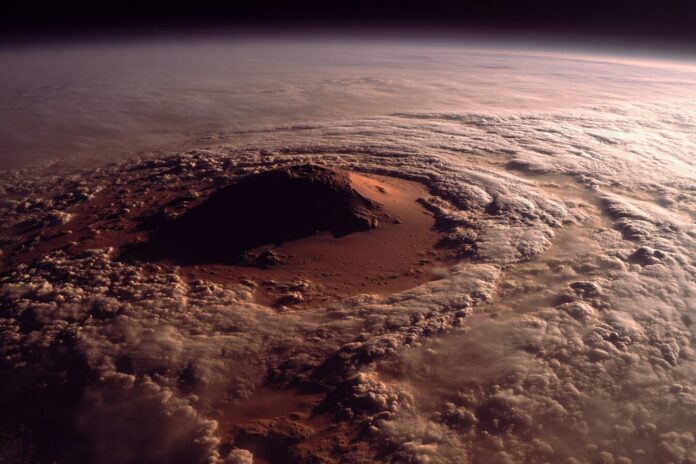Revealing Mars in a New Light: First Horizon Panorama of Arsia Mons
In a groundbreaking achievement, the NASA Mars Orbiter—the 2001 Mars Odyssey—has snapped a spectacular image of Arsia Mons, one of the largest volcanoes on Mars, dramatically peeking above a sprawling canopy of morning clouds. This first-of-its-kind panorama, taken on May 2, 2025, showcases the volcano from the Martian horizon, offering scientists and the public an astronaut-like view of the Red Planet’s towering features [2]. The focus keyphrase “NASA Mars Orbiter” captures the essence of this mission’s continued legacy and the excitement surrounding this unprecedented visual.
The Science Behind the Image: Mars Odyssey and THEMIS
This stunning visual was made possible through the Thermal Emission Imaging System (THEMIS) aboard NASA’s Mars Odyssey. By rotating 90 degrees in orbit, the orbiter was able to point its camera toward the “limb”—the edge of Mars’ horizon—capturing not only surface features but also the layers of atmosphere veiling the planet [1].
Most importantly, this unique vantage point reveals how dust and water-ice cloud layers form and change with the Martian seasons. For context, water-ice clouds are particularly common around the Tharsis Montes, especially during early morning hours, creating mesmerizing scenes like the one now made famous by Odyssey’s camera [4]. The resulting image provides new data to investigate seasonal and atmospheric dynamics, which are crucial for understanding Martian weather patterns and predicting phenomena such as dust storms [1].
Meet Arsia Mons: Mars’ Towering Giant
Standing at about 12 miles (20 kilometers) high, Arsia Mons is nearly twice the height of Mauna Loa, our planet’s largest volcano, which rises roughly 6 miles above the seafloor. The caldera at Arsia Mons’ summit, produced by ancient volcanic explosions and collapse, spans an astounding 72 miles (120 kilometers) in width—dwarfing many Earth volcanoes [1].
What makes this region even more fascinating is its role within the Tharsis Montes (or Tharsis Mountains). This volcanic chain, comprising Arsia Mons and two neighboring giants, is regularly shrouded in clouds, especially during Mars’ aphelion, when the planet is farthest from the Sun. The combination of atmospheric dynamics and volcanic topography creates a scene reminiscent of snow-capped peaks rising through terrestrial fog—except on a planetary scale [4].
Why Horizon Images Matter for Mars Science
Odyssey’s horizon images are more than breathtaking—they provide vital science. By tracking the behavior of clouds and atmospheric layers over time, planetary scientists can map seasonal changes and gain fresh clues about how Mars’ atmosphere evolves. As NASA’s Michael D. Smith notes, “We’re seeing some really significant seasonal differences in these horizon images… It’s giving us new clues to how Mars’ atmosphere evolves over time” [2].
Because climate and weather heavily influence the Red Planet’s potential for future exploration and habitability, these observations are critical. They help researchers anticipate dust storm patterns and understand the planet’s water cycle—key factors for safe robotic and, eventually, human missions.
NASA Odyssey’s Enduring Legacy and Future Discoveries
Launched in 2001, the NASA Mars Orbiter Odyssey remains the longest-running mission orbiting another planet [2]. Since 2023, the spacecraft has adapted to new scientific opportunities by capturing high-altitude, horizon-spanning views—a testament to its operational longevity and the creativity of NASA’s mission teams. This latest achievement with Arsia Mons signals a new era of Martian atmospheric studies and reminds us of the power of perseverance in planetary exploration.
Therefore, the NASA Mars Orbiter Odyssey continues to push the boundaries of space science, revealing Mars in ways never before possible. With each new image, humanity moves closer to unraveling the secrets of the Red Planet and preparing for a future when humans might one day witness such sunrises firsthand.
Further Reading & References
- NASA JPL: Mars Orbiter Captures Volcano Peeking Above Morning Cloud Tops
- THEMIS Views Mars Arsia Mons Volcano
- CBS News: Mars volcano twice as big as Earth’s tallest one seen poking through clouds
- Space Launch Schedule: NASA Mars Orbiter Captures Volcano Peeking Above Morning Cloud Tops



